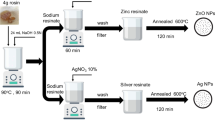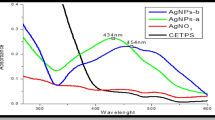Abstract
The study aimed to investigate the influence of solvent polarity (ethanol and distilled water (DW)) on modifying the shape, structure, size, and optical properties of TiO2 nanoparticles (NPs) and Ag-decorated TiO2 (Ag/TiO2) NPs in the chemical medium. It used new, straightforward, and cost-effective growth procedures-dependent solvothermal and hydrothermal methods to produce all samples. The as-synthesized samples were comprehensively characterized using FESEM, XRD, UV-Vis, and FTIR techniques. The findings indicate that the change in the polarity index of the precursor solution produced small and spherical TiO2 NPs with high density. Also, the growth of nanoparticles progressively decreased from 18.07 to 14.51 nm due to the increasing value of the solvent polarity of the reaction medium. Whereas, a lower polarity index of the reaction medium results in a reduction in the energy-gap (Eg) of pure TiO2 NPs from 3.76 to 3.33 eV. The study also estimated the antibacterial and antifungal activities of all as-grown samples and found that the Ag/TiO2 NPs exhibited excellent antibacterial and antifungal activity and selectivity against both Gram-positive and Gram-negative bacteria, as well as fungal micro-organisms when compared to pristine TiO2 NPs.







Similar content being viewed by others
Data Availability
No datasets were generated or analysed during the current study.
References
H.G. Yang et al., Solvothermal synthesis and photoreactivity of anatase TiO2 nanosheets with dominant 001 facets. J. Am. Chem. Soc. 131(11), 4078–4083 (2009)
Y. Khan et al., Classification, synthetic, and characterization approaches to nanoparticles, and their applications in various fields of nanotechnology: a review. Catalysts 12(11), 1386 (2022)
A. Haleem et al., Applications of nanotechnology in medical field: a brief review. Glob. Health J. 7(2), 70–77 (2023)
P. Roy, S. Berger, P. Schmuki, TiO2 nanotubes: synthesis and applications. Angew. Chem. Int. Ed. 50(13), 2904–2939 (2011)
R. Al-Mousawi et al., Degradation of organically polluted water by photocatalysis of SnO2: CuO nanocomposite under the influence of sunlight. Mustansiriyah J. Pure Appl. Sci. 1(3), 103–121 (2023)
A.V. Rane et al., Methods for synthesis of nanoparticles and fabrication of nanocomposites, in Synthesis of Inorganic Nanomaterials. (Elsevier, 2018), pp.121–139
S.A.M. Ealia, M.P. Saravanakumar, A review on the classification, characterisation, synthesis of nanoparticles and their application, in IOP conference series: materials science and engineering. (IOP Publishing, 2017)
A. Ramade, R. Delatorre, D. Duarte, Effect of the oxidation of Al substrates on properties of TiO2 films deposited by spin coating. Braz. J. Phys. 54(1), 27 (2024)
X. Lu et al., Solvent effects on the heterogeneous growth of TiO2 nanostructure arrays by solvothermal synthesis. Catal. Today 360, 275–283 (2021)
V. Kumar et al., Effect of solvent on crystallographic, morphological and optical properties of SnO2 nanoparticles. Mater. Res. Bull. 85, 202–208 (2017)
J. Ungula, B. Dejene, Effect of solvent medium on the structural, morphological and optical properties of ZnO nanoparticles synthesized by the sol–gel method. Phys. B Condens. 480, 26–30 (2016)
P.B. Khoza, M.J. Moloto, L.M. Sikhwivhilu, The effect of solvents, acetone, water, and ethanol, on the morphological and optical properties of ZnO nanoparticles prepared by microwave. J. Nanotechnol. 2012, 6 (2012), Article ID 195106
A. Ejaz, J.H. Han, R. Dahiya, Influence of solvent molecular geometry on the growth of nanostructures. J. Colloid Interface Sci. 570, 322–331 (2020)
Z. Liu et al., Antibacterial and photocatalytic degradation properties of TiO2-based composite. Int. J. Environ. Anal. Chem. 1–8 (2022)
M.T.A. Aydın et al., Synthesis, characterization and antibacterial activity of silver-doped TiO2 nanotubes. Spectrochim. Acta Part A Mol. Biomol. Spectrosc. 205, 503–507 (2018)
P. Kaur et al., Improved magnetism in Cr doped ZnS nanoparticles with nitrogen co-doping synthesized using chemical co-precipitation technique. 26, 9158–9163 (2015)
Y. Zhao et al., Synthesis and optical properties of TiO2 nanoparticles. Mater. Lett. 61(1), 79–83 (2007)
J. Zhang et al., One-pot synthesis of Au/TiO2 heteronanostructure composites with SPR effect and its antibacterial activity. Mater. Lett. 162, 235–237 (2016)
A. Monshi, M.R. Foroughi, M.R. Monshi, Modified Scherrer equation to estimate more accurately nano-crystallite size using XRD. WJNSE 2(3), 154–160 (2012)
X. Lei, X. Xue, H. Yang, Preparation and characterization of Ag-doped TiO2 nanomaterials and their photocatalytic reduction of Cr (VI) under visible light. Appl. Surf. Sci. 321, 396–403 (2014)
M. Suwarnkar et al., Enhanced photocatalytic activity of Ag doped TiO2 nanoparticles synthesized by a microwave assisted method. Ceram. Int. 40(4), 5489–5496 (2014)
F. Yalcinkaya, D. Lubasova, Quantitative evaluation of antibacterial activities of nanoparticles (ZnO, TiO2, ZnO/TiO2, SnO2, CuO, ZrO2, and AgNO3) incorporated into polyvinyl butyral nanofibers. Polym. Adv. Technol.. Adv. Technol. 28(1), 137–140 (2017)
W.J. Aziz, Synthesis of CdSe and CdSe: Ga nanostructures for antibacterial application. Bull. Mater. Sci. 42(4), 148 (2019)
J. Sukitpong, S. Chiarakorn, Degradation of acetaldehyde by Ag/TiO2 photocatalyst coated on polyester air filter, in IOP conference series: earth and environmental science. (IOP Publishing, 2019)
S. Mahalakshmi, P. Vijaya, Evaluation of in-vitro biocompatibility and antimicrobial activities of titanium dioxide (TiO2) nanoparticles by hydrothermal method. Nano Biomedicine and Engineering 13(1), 36–43 (2021)
Acknowledgements
This work was supported by the Mustansiriyah University, College of Science, Department of Physics (Baghdad, Iraq). The authors would like to thank and appreciate all the support submitted by Mustansiriyah University.
Funding
Related to the funding, the authors declare they have no support from any institute or university. This work is achieved and supported by the Authors.
Author information
Authors and Affiliations
Contributions
Ghada R. Khalaf: writing—rough, data curation, conceptualization, methodology, and original draft preparation. Khaldoon N. Abbas: methodology, writing—reviewing and editing, supervision. Asaad M. Abbas: visualization, conceptualization, methodology, writing—rough draft.
Corresponding authors
Ethics declarations
Competing Interests
The authors declare no competing interests.
Additional information
Publisher's Note
Springer Nature remains neutral with regard to jurisdictional claims in published maps and institutional affiliations.
Rights and permissions
Springer Nature or its licensor (e.g. a society or other partner) holds exclusive rights to this article under a publishing agreement with the author(s) or other rightsholder(s); author self-archiving of the accepted manuscript version of this article is solely governed by the terms of such publishing agreement and applicable law.
About this article
Cite this article
Khalaf, G.R., Abbas, K.N. & Abbas, A.M. Effect of Solvent Polarity on the Physical Properties and Antibacterial and Antifungal Activity of TiO2 and Ag/TiO2 Nanoparticles. Braz J Phys 54, 75 (2024). https://doi.org/10.1007/s13538-024-01441-x
Received:
Accepted:
Published:
DOI: https://doi.org/10.1007/s13538-024-01441-x




